Calendar of Appearance of Some Common Insects in the Sonoran Low Desert
Some insects can be found at more or less predictable times each year. This list includes some of the more common insects found in the urban areas of the Sonoran desert. It may help gardeners recognize and prepare for their arrival, but remember, insect d
evelopment is highly dependent on temperature and weather conditions. Insect numbers and appearance times may vary considerably from year to year.
January
Various beetles may emerge from firewood stored in homes, such as long-horned beetles or metallic wood borers. Do not be overly concerned if you find some because they can not attack the dry, finished wood of a typical home. Simply vacuum them up.
 Fungus gnats are small gray flies that periodically emerge from potted plants. The gnats may be a nuisance when flying to windows, but do no harm to humans. Most k
inds feed on organic matter in the soil. To reduce their numbers, re-pot the plant into soil less rich in organic matter, let the plant dry out sufficiently between waterings and set plants outdoors when adult gnats are emerging. Vacuum up any adult gnats
attracted to lights or windows.
Fungus gnats are small gray flies that periodically emerge from potted plants. The gnats may be a nuisance when flying to windows, but do no harm to humans. Most k
inds feed on organic matter in the soil. To reduce their numbers, re-pot the plant into soil less rich in organic matter, let the plant dry out sufficiently between waterings and set plants outdoors when adult gnats are emerging. Vacuum up any adult gnats
attracted to lights or windows.
February
Aphids are cool season insects. They are found on the growing tips and buds of many annual plants and shrubs, where they suck the plant sap. Hose aphids off or spray them with soapy water. Add one teaspoon to one tablespoon of non-concentrated dish deterg
ent to one gallon of water. Before spraying the entire plant, always spray a few leaves and check the next day for leaf burn.
Look for aphid mummies. These are aphids that turn brown and harden up or freeze on the plant. Aphid mummies are caused by tiny parasitic wasps that lay their eggs within the aphid. The wasp egg hatches into a larva that feeds inside the living aphid. Whe
n the wasp has about completed its life cycle it releases chemicals that cause the aphid to harden. Shortly afterwards, the wasp will emerge. Leave mummies alone; they will help take care of your aphid problems.
Palo verde buck moth adults are out. These brown and white moths will lay eggs that hatch into hairy caterpillars on palo verde trees. The hairs of the caterpillar are irritating to the skin and should not be touched. These native insects cause little har
m to the tree and are kept under control by several beneficial insects. Control is generally not necessary.
March
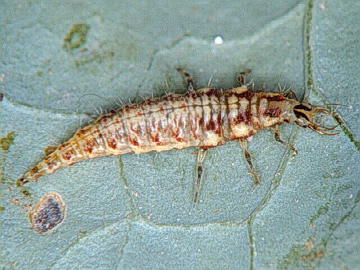 Aphids are still abundant, but there are also more predators such as lacewings and lady beetles. Lacewings are pale green insects about one inch long and have shiny golden eyes. When in flight they may resemble delicate moths. The larval stage preys on ma
ny small soft-bodied insects including aphids. Lacewing larvae are reddish cream in color and are tapered in shape like tiny alligators.
Aphids are still abundant, but there are also more predators such as lacewings and lady beetles. Lacewings are pale green insects about one inch long and have shiny golden eyes. When in flight they may resemble delicate moths. The larval stage preys on ma
ny small soft-bodied insects including aphids. Lacewing larvae are reddish cream in color and are tapered in shape like tiny alligators.
Along with citrus flowering comes the arrival of citrus thrips. Shake citrus blossoms over a piece of white paper and look for tiny yellow insects that resemble wood splinters. Thrips scar the fruit and cause the new leaves to twist and curl. Control is n
ot justified for typical backyard citrus, however, because the scarring does nothing to harm the internal quality of the fruit. Furthermore improperly timed insecticide treatments can drastically reduce fruit yield.
Western tent caterpillars are found at higher elevations as trees start to leaf out. They form web-like tent nests out of silk at the ends of tree branches. If infestations are light, simply prune out the nests and destroy them.
Grape flea beetles may attack Mexican primrose causing tattered flowers. Apply carbaryl dust to plants before the damage occurs if you have had this problem in the past.
Homeowners may find flower beetles in their roses. These torpedo-shaped brown or black beetles feed on nectar and pollen within the flower. They don't cause harm but may be a nuisance. Gently tap the beetles out of roses before bringing the flowers indoor
s.
When grapes begin to leaf out, look for grape leaf skeletonizer moths. These shiny, jet-black moths are about 3/4 inch long and tend to fly in the early morning. They lay clusters of bright yellow eggs on grape leaves. The bright yellow and blue striped c
aterpillars feed in clusters causing leaves to have a net-like appearance. Beware of handling the caterpillars; they have stinging spines. Control them with Bt caterpillar control products. Crush egg masses. Wear a dust mask and gloves if you decide to pi
ck and crush the larvae.
Mustard yellow paper wasps are out now looking for places to nest. Although paper wasps may be considered to be beneficial because they feed on other pest insects, they can sting if threatened. Commercially available wasp and hornet sprays will control th
em. After controlling the wasps always remove the nest completely, including the stem that attaches the nest to the surface, because the nests have odors that will attract other wasps.
April
Clouds of false chinch bugs may startle homeowners in certain neighborhoods. These active gray plant bugs normally feed on weeds and are totally harmless, but, when they cluster into large groups in the spring, they may become a nuisance. Fortunately, the
y do not attack landscape plants and are not a health risk. Usually they disappear as quickly as they came. Otherwise, insecticides will control them. Always read the label carefully and use products registered for outdoor use.
Aphids are probably beginning to disappear with the arrival of warmer temperatures. White, fuzzy wooly aphids may be found on apple or pyracantha. Wash them off with a hose.
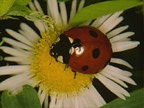 Lady bird beetles are a great defense against aphids. The red-orange and black adults we are so familiar with lay bright orange football-shaped eggs on plants near where aphids are found.
Lady bird beetles are a great defense against aphids. The red-orange and black adults we are so familiar with lay bright orange football-shaped eggs on plants near where aphids are found.
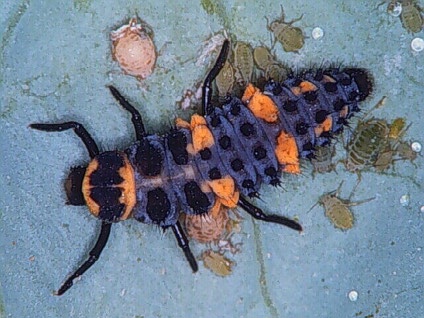 The eggs hatch into black and orange bumpy larvae that eat hundreds of aphids per day. Don't be alarmed by the orange and black pupa stage resting on plants, i
t will turn into a beetle in a few days.
The eggs hatch into black and orange bumpy larvae that eat hundreds of aphids per day. Don't be alarmed by the orange and black pupa stage resting on plants, i
t will turn into a beetle in a few days.
People begin to see black thumb-sized carpenter bees coming to visit flowers. Carpenter bees nest in unfinished logs such as firewood or decorative tree stumps. They are important pollinators. The females can sting if picked up or stepped on, but are not
aggressive at all and should be left alone.
May
Agave weevils are shiny black beetles with a long snout when viewed from the side. They can not fly so they walk from agave to agave. They feed on and introduce a bacteria into agaves that causes rapid collapse of the plant. The weevil larvae consume the
weakened, rotting tissues. Immediately remove and destroy any collapsed agaves, including the roots. If you’ve had infestations in the past, sprinkle diazinon around uninfested plants during the spring to prevent adults from gaining access. The adults eme
rge again in the fall.
The beautiful black and yellow giant swallowtail butterflies may be seen around citrus at this time of year. They lay eggs on fresh citrus leaves that hatch into the so-called orange dog caterpillars. Orange dogs are gray, brown and white mottled caterpil
lars that strongly resemble bird droppings. They consume only a few leaves during their lifetime and are susceptible to naturally occurring parasites and predators. Control is not necessary. Orange dog caterpillars make great science projects for kids stu
dying metamorphosis in insects.
Blister beetles may be seen clustered on flowers in yards where they are feeding on pollen. Many different kinds are found in Arizona, ranging from black to yellow and red in color. All contain a toxic material that causes burning or blistering of the ski
n if the beetles are picked up or handled. Blister beetles are a concern to people who own horses because if a horse accidentally consumes one crushed in its hay it can become very sick or even die. On the other hand, the blister beetle larvae feed on gra
sshopper eggs and could be considered beneficial. Do not pick up beetles with your bare hands and warn children to stay away from them.
May or June beetles (also called chafer beetles) are attracted to lights at night. These rounded yellow-brown beetles have noticeable spines on their legs for digging. They lay their eggs in soil. The eggs hatch into “white grubs” which feed on roots of t
urf and certain annual plants. White grubs may be controlled using beneficial nematodes or with pesticides available from lawn and garden supply stores.
Leafcutter bees remove round bits of leaf from roses and other ornamentals. The bees use the leaf pieces to line their nests. Even when the activity is heavy, the bees do not remove enough leaf material to seriously harm the plant. Because these bees are
also important pollinators, they are considered to be beneficial. To protect special show roses, cover them with a floating row cover during the weeks prior to a show.
June
Every year the cicadas emerge around Father's Day. These large insects are heard singing or buzzing in the trees during the hot days of summer. Their offspring feed underground on roots. When they exit the ground the nymphs cling to sides of building or t
o tree trunks. When the adult cicada emerges, the brown skin of the nymph is left behind. Unlike white grubs, the cicadas are not thought to cause any damage to plants and are susceptible to naturally occurring fungal diseases. Control is not necessary.
Whenever a homeowner finds a green or pink caterpillar in their carpeting or paper products this time of year, it is inevitably a palm caterpillar. These caterpillars feed on palm flowers. Normally they pupate on or near the plant, but sometimes they are
knocked off by pruning or by storms and wander indoors, particularly if the plant is surrounded by a patio. To avoid more caterpillars, don't prune palms while they are flowering and seal up cracks and crevices in your home, particularly under patio doors
. Remove any caterpillars found inside.
With summer monsoon rains come flying ants and termites. This time of year ant and termite colonies produce literally thousands of winged individuals that swarm out to mate and found new colonies. Although the sheer numbers of insects that appear at once
may be alarming, the swarm is usually short term. Most of the insects end up being eaten by other creatures, particularly birds. Be concerned, however, if winged termites swarm from within the house. If this is the case, a termite inspection is in order.<
BR>
Sharpshooters are shy, elongate insects that feed on numerous shrubs and trees. They are often brightly colored, with green and red stripes or orange spots. Sharpshooters feed on plant sap and are known to excrete large quantities of liquid in the form of
honeydew. Keep plants well watered and properly maintained, and sharpshooters should not be a problem.
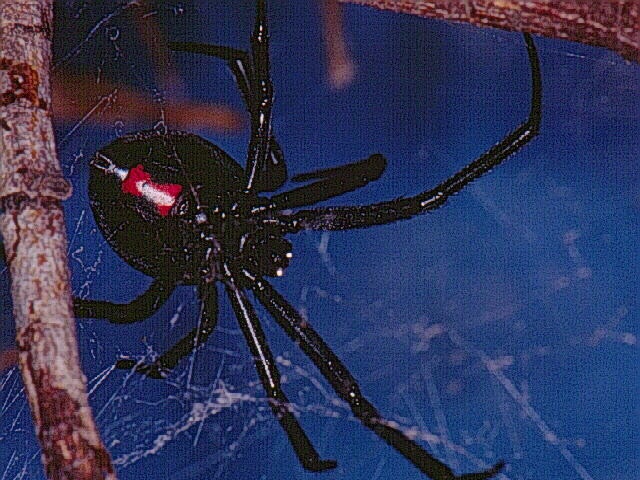 Black widow spiders and scorpions are highly active during hot summer nights. Look for black widows with a flashlight at night; they will be hanging upside down
in their webs. Look for bark scorpions with a ultraviolet light or blacklight at night. Destroy any found. Always wear closed shoes (not sandals) outside at night.
Black widow spiders and scorpions are highly active during hot summer nights. Look for black widows with a flashlight at night; they will be hanging upside down
in their webs. Look for bark scorpions with a ultraviolet light or blacklight at night. Destroy any found. Always wear closed shoes (not sandals) outside at night.
Although the sting of a scorpion is painful, it is generally not life threatening. There is only one species of scorpion that is potentially dangerous, and that is the bark scorpion. If you believe you have been stung by a bark scorpion, you should call y
our local Poison Control Center: (602) 253-3334 in Phoenix.
Tomato hornworms or tobacco hornworms are large green caterpillars with a spike or horn on their tail. They feed on and defoliate tomato plants. For small plots, keep a vigilant eye out and hand-pick and destroy any caterpillars found. When tilling look f
or the cigar-shaped pupal stage buried in the soil. Tomato hornworms are susceptible to natural enemies such as parasites or birds.
Giant palm borer beetles are relatively new to Arizona. These dark brown to almost black beetles emerge from the trunks of palm trees leaving a hole the size of a quarter. The larval stage is a large grub that tunnels and feeds within the palm. Heavily in
fested palms are a potential hazard because they are likely to break or fall over in a strong wind and should be taken down.
Conenose or kissing bugs are up to 1 1/4 inch long, dark brown insects with yellow or red markings. They normally feed on the blood of rodents, especially the white-throated wood rat ("pack rat"). They also feed on humans at night, usually when the person
is sleeping. The bugs inject an anticoagulant to stimulate blood flow, which may cause an allergic reaction with repeated bites. If you suspect you have been bitten by a conenose bug and might be allergic, call your local poison control center immediatel
y.
If conenose bugs are a problem in your area, make a special effort to keep them out of sleeping areas. Seal around bedroom doors with weather-stripping, and keep doors closed as much as possible. Conenose bugs hide during the day in the bedroom, so check
bedding and furniture regularly. Destroy any insects found. If you decide to use an insecticide, choose a crack and crevice formulation and be sure to treat under the bed. Use a bed net when camping where pack rats may nest, for example around caves.
July
Nothing causes more alarm at first viewing that a sunspider (also called windscorpion). These spider-relatives have massive jaws that give them a ferocious appearance. They are actually relatively harmless, however, and only use their jaws to capture and
eat insects. They are attracted to lights at night.
Palo verde borers are large (three to five inches long) dark-brown beetles with long antennae and a "collar" of spines behind their head. The adult beetles are often attracted to outdoor lights at night. Although their appearance is intimidating, they are
harmless if left alone. Their common name is misleading because they do not seem to feed on the native foothills or blue palo verde trees, although they do feed on Mexican palo verdes. The immatures (grubs) bore into and feed on the roots of several non-
native trees and shrubs. Evidence suggests that the beetles are attracted to trees weakened by disease or stress, and those factors, rather than the beetles, may kill the tree. The best way to prevent problems is to keep your trees and shrubs properly wat
ered and fertilized.
Indian house crickets and cockroaches are both urban pests. They feed on anything from rotting garbage to dog food, and can reach high populations in the summer. They are particularly active at night. To get rid of crickets and cockroaches indoors, use bo
ric acid powder, cockroach traps or sticky traps. To control these pests outdoors, encourage natural enemies such as geckos, praying mantids and spiders. Insecticide sprays are also effective.
Although imported fire ants are not found in Arizona, their cousins, the native fire ants, are abundant here. Fire ants nest in open, disturbed areas such as most urban landscapes. When stirred up by construction or adverse weather they will readily enter
homes where they form dense trails of hundreds of ants. To keep fire ants outside, seal or caulk up any cracks. Use ant control such as granular baits outside or ant traps inside. Insecticides are available from many household supply stores. Ants and ter
mites are still likely to swarm after monsoon rains.
Praying mantids do very well in Arizona. These pale green or light brown insects are long and slender and somewhat resemble stems or twigs. They sit with their enlarged front legs held upright, ready to spring and grasp any insect prey that wanders by. On
ce mature, the females lay their eggs in glistening brown packages that harden into a material that looks like styrofoam. Look for these egg cases on walls and stems of shrubs.
August
Summer dust storms encourage outbreaks of spider mites. Suspect your plants are infested with spider mites if they begin to yellow and are covered with fine threads that resemble spiders' webs. A simple solution is to wash the webs and dust off from the p
lants with a hose. Spider mites may attack indoor plants at any time of the year.
Green fig beetles (also known as sour fruit beetles) are round, shiny green beetles about the size of the end of your thumb. They cluster on unripened fruit and may be a pest. The larvae are found in compost heaps and soil with a great deal of organic mat
ter. They are part of nature’s recycling program. If the adults become a pest, cover fruit with a paper bag prior to harvest.
Brown dog ticks can reach high numbers in yards at this time of year. These eight-legged parasites range in size from tiny seed ticks found in the yard or on the walls to nearly half-inch-long engorged females found on the dog. Management requires combine
d treatment of the dog's environment with insecticides and treating the dog at the same time to remove any ticks on it's body. Various tick and flea control products are available from pet shops or lawn and garden supply stores.
Indian house crickets and cockroaches are still in high numbers. Do not fret however, they will slow down when temperatures drop.
Whiteflies start to really build up towards the end of August.
Big-eyed bugs are rice-grain-sized light gray insects that are named for the fact that their large eyes bulge at the sides of their heads. They are efficient predators of other insects that feed on moth eggs, small caterpillars and even on whiteflies. Red
uce pesticide use to encourage big-eyed bugs.
September
September is the month for caterpillar migrations. Armyworms, salt marsh caterpillars, and white-lined sphinx caterpillars may reach high numbers and be seen crawling across roads or through yards. Although they are usually in search of a place to pupate
and not harmful to landscape plants, they can still be a nuisance problem due to their sheer numbers.
Darkling beetles are 1/4 to 1/2 inch long, hard shelled, dull bluish-black or brown beetles that become nuisance pests when they enter homes in large numbers. The insects build up in the spring on weeds. As the vegetation dries up in the summer heat, the
adult beetles fly into yards where they are attracted by lights or moisture. The best way to "control" darkling beetles is to prevent them. Clean up all weeds early in the spring. Remove dead leaves and plant remains throughout the summer. Shut off outsid
e lights when not in use. To keep the beetles out of your house, seal up cracks around doors or windows, and repair screens. Indoor infestations may be controlled with a fly swatter or with a vacuum cleaner.
In the last few years, high numbers of whiteflies have been found in urban areas in September. The strategy has been to protect the few most susceptible plants such as lantana and hibiscus, either with soap and water sprays or with floating row covers. Al
so, delay planting fall vegetables until the second week of October or when temperatures begin to decline.
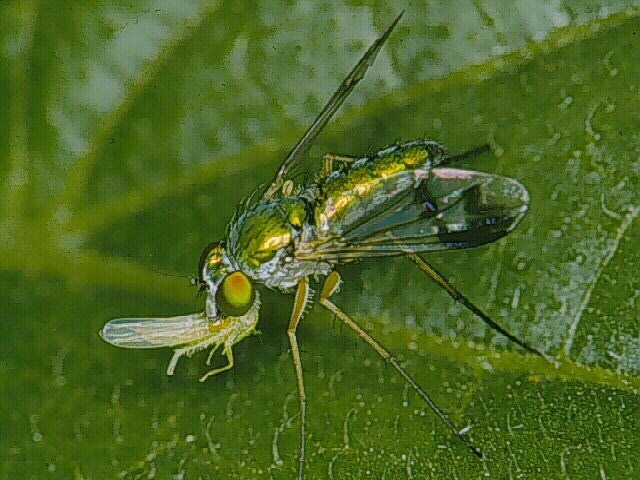 Long-legged flies are shiny metallic green flies slightly smaller and more slender bodied than a regular house fly. They are found sitting on the leaves of many
shrubs and trees. Although we think of most flies as pests, these flies are beneficial because they feed on small insects such as leafhoppers. Other flies that are predators include robber flies and the larvae of flower flies.
Long-legged flies are shiny metallic green flies slightly smaller and more slender bodied than a regular house fly. They are found sitting on the leaves of many
shrubs and trees. Although we think of most flies as pests, these flies are beneficial because they feed on small insects such as leafhoppers. Other flies that are predators include robber flies and the larvae of flower flies.
October
October is when temperatures begin to decline and many of the summer insects start to disappear. It is also a time when some insects start to cluster together and these can become pests just by their sheer numbers. For example, false boxelder bugs tend to
cluster in large groups for overwintering, and unsettled homeowners may find the bugs have picked the side of their homes for a gathering place. False boxelder bugs are bright red and black. They get their name for their resemblance to true boxelder bugs
found around boxelder trees in cooler climates.
Hairy fungus beetles are small, reddish brown beetles about 1/10th of an inch long. They resemble flour beetles, and become nuisances by invading new homes in high numbers. They may be attracted to glues used in cabinets and are often found in kitchen and
bathroom drawers. Under certain conditions, there may be hundreds of these beetles. Usually they disappear as mysteriously and rapidly as they appeared. If necessary, most common insecticides will kill them.
Assassin bugs feed on insect pests such as caterpillars. They often are found sitting and waiting on flowers or vegetables for food to stroll by. They may look a little like small praying mantids because of the way they hold their front legs but are darke
r in color.
November
Springtails get into homes and swimming pools.
December
People tend to bake more during the holidays. This often means containers are opened that haven’t been opened for months, and pantry pests such as Indian meal moth, red flour beetles or saw-toothed grain beetles are discovered. If beetles, moths or worms
are found in flour or cereal products, it is best to discard the infested materials. Store flours and grains in air-tight containers or in the freezer. Be sure to check dried pet food as well as human food.
 Fungus gnats are small gray flies that periodically emerge from potted plants. The gnats may be a nuisance when flying to windows, but do no harm to humans. Most k
inds feed on organic matter in the soil. To reduce their numbers, re-pot the plant into soil less rich in organic matter, let the plant dry out sufficiently between waterings and set plants outdoors when adult gnats are emerging. Vacuum up any adult gnats
attracted to lights or windows.
Fungus gnats are small gray flies that periodically emerge from potted plants. The gnats may be a nuisance when flying to windows, but do no harm to humans. Most k
inds feed on organic matter in the soil. To reduce their numbers, re-pot the plant into soil less rich in organic matter, let the plant dry out sufficiently between waterings and set plants outdoors when adult gnats are emerging. Vacuum up any adult gnats
attracted to lights or windows. Aphids are still abundant, but there are also more predators such as lacewings and lady beetles. Lacewings are pale green insects about one inch long and have shiny golden eyes. When in flight they may resemble delicate moths. The larval stage preys on ma
ny small soft-bodied insects including aphids. Lacewing larvae are reddish cream in color and are tapered in shape like tiny alligators.
Aphids are still abundant, but there are also more predators such as lacewings and lady beetles. Lacewings are pale green insects about one inch long and have shiny golden eyes. When in flight they may resemble delicate moths. The larval stage preys on ma
ny small soft-bodied insects including aphids. Lacewing larvae are reddish cream in color and are tapered in shape like tiny alligators. Lady bird beetles are a great defense against aphids. The red-orange and black adults we are so familiar with lay bright orange football-shaped eggs on plants near where aphids are found.
Lady bird beetles are a great defense against aphids. The red-orange and black adults we are so familiar with lay bright orange football-shaped eggs on plants near where aphids are found.
 The eggs hatch into black and orange bumpy larvae that eat hundreds of aphids per day. Don't be alarmed by the orange and black pupa stage resting on plants, i
t will turn into a beetle in a few days.
The eggs hatch into black and orange bumpy larvae that eat hundreds of aphids per day. Don't be alarmed by the orange and black pupa stage resting on plants, i
t will turn into a beetle in a few days. Black widow spiders and scorpions are highly active during hot summer nights. Look for black widows with a flashlight at night; they will be hanging upside down
in their webs. Look for bark scorpions with a ultraviolet light or blacklight at night. Destroy any found. Always wear closed shoes (not sandals) outside at night.
Black widow spiders and scorpions are highly active during hot summer nights. Look for black widows with a flashlight at night; they will be hanging upside down
in their webs. Look for bark scorpions with a ultraviolet light or blacklight at night. Destroy any found. Always wear closed shoes (not sandals) outside at night. Long-legged flies are shiny metallic green flies slightly smaller and more slender bodied than a regular house fly. They are found sitting on the leaves of many
shrubs and trees. Although we think of most flies as pests, these flies are beneficial because they feed on small insects such as leafhoppers. Other flies that are predators include robber flies and the larvae of flower flies.
Long-legged flies are shiny metallic green flies slightly smaller and more slender bodied than a regular house fly. They are found sitting on the leaves of many
shrubs and trees. Although we think of most flies as pests, these flies are beneficial because they feed on small insects such as leafhoppers. Other flies that are predators include robber flies and the larvae of flower flies.